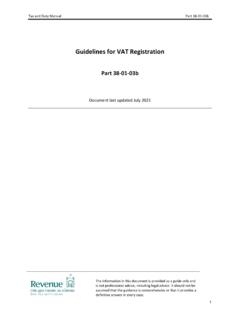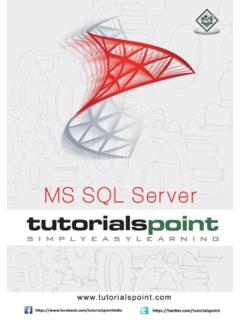Transcription of About the Tutorial
1 SharePoint i About the Tutorial This Tutorial will give you an idea of how to get started with SharePoint development. Microsoft SharePoint is a browser-based collaboration, document management platform and content management system. After completing this Tutorial , you will have a better understating of what SharePoint is and what are the high-level feature areas and functionalities of SharePoint. Audience This Tutorial has been prepared for anyone has an urge to develop websites and Apps. After completing this Tutorial you will find yourself at a moderate level of expertise in developing websites and Apps using SharePoint.
2 Prerequisites Before you start proceeding with this Tutorial , we are assuming that you are already aware About the basics of Web development. Copyright & Disclaimer Copyright 2016 by Tutorials Point (I) Pvt. Ltd. All the content and graphics published in this e-book are the property of Tutorials Point (I) Pvt. Ltd. The user of this e-book is prohibited to reuse, retain, copy, distribute or republish any contents or a part of contents of this e-book in any manner without written consent of the publisher. We strive to update the contents of our website and tutorials as timely and as precisely as possible, however, the contents may contain inaccuracies or errors.
3 Tutorials Point (I) Pvt. Ltd. provides no guarantee regarding the accuracy, timeliness or completeness of our website or its contents including this Tutorial . If you discover any errors on our website or in this Tutorial , please notify us at SharePoint ii Table of Contents About the Tutorial .. i Audience .. i Prerequisites .. i Copyright & Disclaimer .. i Table of Contents .. ii 1. SharePoint Overview .. 1 What is SharePoint .. 1 2. SharePoint Types .. 3 SharePoint Foundation .. 3 SharePoint Server .. 4 Office 365 .. 4 3. SharePoint Capabilities .. 6 SharePoint 2013 Capabilities .. 6 4. SharePoint Setup Environment.
4 8 Installation .. 14 5. SharePoint Create Site Collection .. 22 Create Site Collection .. 22 6. SharePoint APIs .. 27 7. SharePoint Central Administration .. 30 8. SharePoint App Model .. 35 SharePoint-hosted App .. 35 Autohosted .. 51 9. SharePoint Integration Options .. 54 User Interface Integration .. 54 Events and Logic Integration .. 55 Data Integration .. 55 10. SharePoint Development Tools .. 57 Site Settings .. 57 Add HTML page .. 59 Add Media file .. 62 SharePoint Designer .. 64 Visual Studio and Expression Blend .. 70 11. SharePoint List Functionality .. 87 12. SharePoint Additional List 94 Views.
5 94 Validation .. 98 Lookup Fields .. 108 List Data Storage .. 113 13. SharePoint Custom List .. 114 SharePoint iii 14. SharePoint Libraries .. 131 Creating a Document Library .. 131 Add a Document to Library .. 137 15. SharePoint Web Part .. 148 16. SharePoint Site Column & Content Types .. 157 Content Types .. 170 17. SharePoint SharePoint Data .. 181 18. SharePoint Server Object Model .. 185 Features of Server Object Model .. 185 List Data .. 192 CAML Queries .. 196 19. SharePoint Client Object Model .. 199 Retrieve Resources with Load using . 200 20. SharePoint REST APIs .. 205 Retrieve Resources using REST API.
6 209 21. SharePoint Features & Elements .. 218 22. SharePoint Feature\Event Receiver .. 240 23. SharePoint Azure Platform .. 248 Cloud Computing .. 248 Azure Platform Overview .. 248 SharePoint Apps and Microsoft Azure .. 264 24. SharePoint Packaging & Deploying .. 266 Farm Solution 270 25. Sharepoint Sandbox 274 26. SharePoint SharePoint Apps .. 282 App Characteristics .. 282 App Types .. 283 Autohosted .. 299 SharePoint 1 This Tutorial will give you an idea of how to get started with SharePoint development. Microsoft SharePoint is a browser-based collaboration, document management platform and content management system.
7 After completing this Tutorial , you will have a better understating of what SharePoint is and what are the high-level feature areas and functionalities of SharePoint. What is SharePoint SharePoint is a platform to support collaboration and content management system. It is a central web-based portal. Using SharePoint, you can manage your colleague s and your own documents, social activities, data, and information. It allows groups to set up a centralized, password-protected space for document sharing. Documents can be stored, downloaded and edited, then uploaded for continued sharing. SharePoint offers such a wide array of features that it is very challenging for any one person to be an expert across all the workloads.
8 Let us understand what all can we do with SharePoint. It is divided into three separate areas- Collaboration The term collaboration contains a very strong theme for SharePoint. It means bringing people together through different types of collaboration, such as enterprise content management, Web content management, social computing, discoverability of people and their skills. In SharePoint 2013, collaboration is managed through Apps. Developers can extend, customize, or build their own Apps for SharePoint as well manage collaboration on SharePoint. 1. SharePoint Overview SharePoint 2 Interoperability SharePoint is also About bringing this collaboration together through interoperability such as- Office and web-based document integration.
9 Capability to build and deploy secure and custom solutions that integrate line-of-business data with SharePoint and Office. Integrating with wider web technologies, or deploying applications to the cloud. Platform SharePoint is also a platform that supports not only interoperability and collaboration but also extensibility, through a rich object model, a solid set of developer tools, and a growing developer community. One of the key paradigm shifts is the notion of the cloud in SharePoint. The cloud introduces new App models such as- o New ways of developing, deploying, and hosting SharePoint applications. o New forms of authentication through OAuth.
10 O New ways of data interoperability using OData and REST. SharePoint 3 In this chapter, we will be covering the different types and versions to start working on SharePoint. There are three main ways to install and use SharePoint- SharePoint Foundation SharePoint Server Office 365 The first two options are SharePoint on-premise, while Office 365 has emerged as a third, fully cloud-hosted model for SharePoint. SharePoint Foundation SharePoint Foundation is the essential solution for organizations that need a secure, manageable, web-based collaboration platform. SharePoint Foundation provides you with the basic collaboration features that are included within SharePoint.











